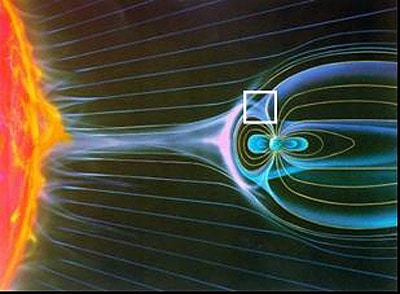A team of European scientists has discovered a new type of vortex in the Earth's magnetosphere. The drift-kinetic Alfvén vortices seen by the team measure tens of kilometres across and were discovered in data from the Cluster mission. Last year another group discovered Kelvin-Helmholtz vortices, which are several thousands of kilometres across, in data from the same mission. The results could help shed more light on the effects of turbulence in both space and laboratory plasmas (Nature 436 825).

The Earth’s magnetosphere is the region around our planet where phenomena are dominated by the Earth’s magnetic field (figure 1). Outside the magnetosphere, the influence of the solar wind — a supersonic plasma of charged particles from the Sun — becomes dominant.
Scientists have long believed that turbulent plasmas, like those in the magnetosphere, should create vortices. However, these structures had not been observed unambiguously until David Sundkvist of the Swedish Institute of Space Physics and colleagues in France and Germany analysed data from Cluster, a fleet of four identical spacecraft that was launched in 2000.
Sundkvist and co-workers analyzed data from all four satellites to determine how the magnetic field in the magnetosphere varies with position. “Using more than one measurement point is the only way get information about spatial phenomena and distinguish them from temporal phenomena, without making assumptions,” Sundkvist told PhysicsWeb. “The observations were compared with theory and simulations, and showed striking agreement.”
Vortices can transport mass and energy across natural boundaries set up by magnetic fields, says Sundkvist. An example of such a barrier is the “magnetopause” that exists between the magnetosphere and the solar wind. Other examples are found in laboratory experiments with fusion plasmas. “Vortices are believed to cause the ‘anomalous transport’ of plasma across the magnetic field that confines the plasma, which is a problem in fusion research,” says Sundkvist. “Our findings could help us better understand turbulent plasma phenomena and these anomalous transport effects,”
The scientists now hope to discover how the vortices are created and how much energy and mass they transport. They would also like to find out if the vortices are stable, or if they collapse into smaller structures or coalesce into larger ones.





